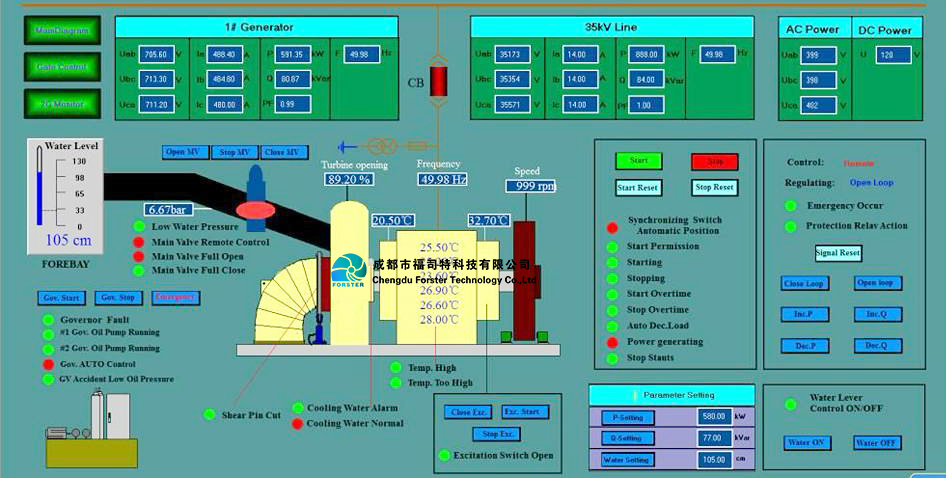In natural rivers, water flows from upstream to downstream mixed with sediment, and often washes the river bed and bank slopes, which shows that there is a certain amount of energy hidden in the water. Under natural conditions, this potential energy is consumed in scouring, pushing sediment and overcoming frictional resistance. If we build some buildings and install some necessary equipment to make a steady stream of water flow through a water turbine, the water turbine will be driven by the water current, like a windmill, that can rotate continuously, and the water energy will be converted into mechanical energy. When the water turbine drives the generator to rotate together, it can generate electricity, and the water energy is converted into electrical energy. This is the basic principle of hydroelectric power generation. Water turbines and generators are the most basic equipment for hydroelectric power generation. Let me give you a brief introduction to the little knowledge about hydroelectric power generation.
1. Hydropower and water flow power
In the design of a hydropower station, in order to determine the scale of the power station, it is necessary to know the power generation capacity of the power station. According to the basic principles of hydroelectric power generation, it is not difficult to see that the power generation capacity of a power station is determined by the amount of work that can be done by the current. We call the total work that water can do in a certain period of time as water energy, and the work that can be done in a unit of time (second) is called current power. Obviously, the greater the power of the water flow, the greater the power generation capacity of the power station. Therefore, to know the power generation capacity of the power station, we must first calculate the water flow power. The water flow power in the river can be calculated in this way, assuming that the water surface drop in a certain section of the river is H (meters), and the water volume of H passing through the cross-section of the river in unit time (seconds) is Q (cubic meters/second), then the flow The section power is equal to the product of the weight of the water and the drop. Obviously, the higher the water drop, the greater the flow, and the greater the water flow power.
2. The output of hydropower stations
Under a certain head and flow, the electricity that a hydropower station can generate is called hydropower output. Obviously, the output power depends on the power of the water flow through the turbine. In the process of converting water energy into electrical energy, water must overcome the resistance of riverbeds or buildings along the way from upstream to downstream. Water turbines, generators, and transmission equipment must also overcome many resistances during work. To overcome resistance, work must be done, and water flow power will be consumed, which is inevitable. Therefore, the water flow power that can be used to generate electricity is smaller than the value obtained by the formula, that is to say, the output of the hydropower station should be equal to the water flow power multiplied by a factor less than 1. This coefficient is also called the efficiency of a hydropower station.
The specific value of the efficiency of a hydropower station is related to the amount of energy loss that occurs when the water flows through the building and the water turbine, transmission equipment, generator, etc., the greater the loss, the lower the efficiency. In a small hydropower station, the sum of these losses accounts for about 25-40% of the power of the water flow. That is to say, the water flow that can generate 100 kilowatts of electricity enters the hydropower station, and the generator can only generate 60 to 75 kilowatts of electricity, so the efficiency of the hydropower station That is equivalent to 60~75%.

It can be seen from the previous introduction that when the power station’s flow rate and water level difference are constant, the power output of the power station depends on the efficiency. Practice has proved that in addition to the performance of hydraulic turbines, generators and transmission equipment, other factors affecting the efficiency of hydropower stations, such as the quality of building construction and equipment installation, the quality of operation and management, and whether the design of the hydropower station is correct, are all factors that affect the efficiency of the hydropower station. Of course, some of these influencing factors are primary and some are secondary, and under certain conditions, the primary and secondary factors will also transform into each other.
However, no matter what the factor is, the decisive factor is that people are not objects, machines are controlled by humans, and technology is governed by thought. Therefore, in the design, construction and equipment selection of hydropower stations, it is necessary to give full play to the subjective role of human beings, and to strive for excellence in technology to minimize the energy loss of water flow as much as possible. This is for some hydropower stations where the water drop itself is relatively low. It is especially important. At the same time, it is necessary to effectively strengthen the operation and management of hydropower stations, so as to improve the efficiency of power stations, make full use of water resources, and enable small hydropower stations to play a greater role.
Post time: Jun-09-2021
